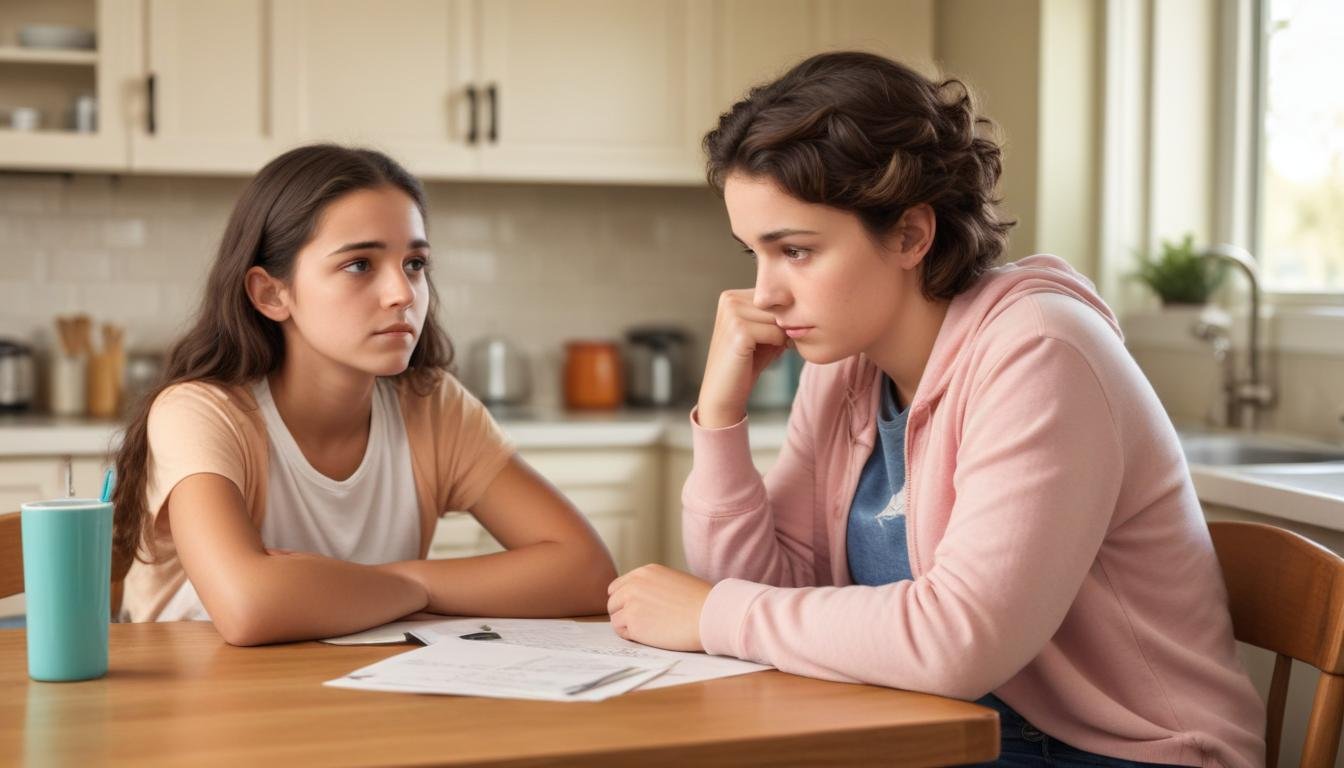Identifying Red Flags in Social Media Profiles
When I look at my kids’ social media profiles, I sometimes notice things that concern me. I want to share with you what I’ve learned about spotting red flags in social media accounts. As a parent of four, I know how important it is to keep our children safe from social media risks. It’s easy to overlook a few details, but those details can tell us a lot!
For instance, I remember when my daughter, Patricia, showed me a new account she wanted to follow. At first glance, it looked fun with bright colors and catchy posts. But then I noticed that the account didn’t have a real name, just a weird username. It felt a bit off. I gently asked her about it and suggested we look deeper, just like we would if we were checking out a new friend. She learned that not everyone online is who they say they are, and now she knows to be careful.
Another thing to watch for is how often an account posts. If an account posts too much or has a lot of followers but really few likes, that can be a sign it might not be genuine. Mark and Matthew, my twin boys, like to follow cool sports accounts. I taught them to notice the difference between real accounts, like their favorite athletes, and fake ones that just share silly memes. It’s all about building teen awareness, so they can make smart choices!
Don’t forget about the pictures too! If an account often shares inappropriate or shocking images, it’s a huge red flag. I have told my kids that they can always come to me if they see something that makes them uncomfortable. It’s always better to talk about it. With our love and guidance, we can help them navigate this wild world of social media.
As parents, we can definitely give each other parenting help in this area. Just the other day, at a family gathering, I shared stories with my parents and Michelle’s parents about these things. They all had ideas on how to keep our kids safe online. We must stay connected and supportive as a family, looking out for each other. By being aware and vigilant together, we’re giving our children the best chance to enjoy social media while staying protected.
Understanding Harmful Content and Its Impact

When my kids use social media, I know they might come across things that can be harmful or upsetting. It’s important to understand the kind of content that can affect them. As a cybersecurity expert, I’ve seen many examples of content that could worry any parent. You might be surprised to hear that even seemingly innocent posts can carry messages that are not good for our kids.
For instance, there are accounts that focus too much on looks or being perfect. I’ve seen images that make it seem like everyone should look a certain way. It makes me think about how my daughter, Patricia, sometimes talks about her friends wanting to dress like popular influencers. I want her to know that it’s okay to be herself, just like I encourage my twin boys to embrace their unique personalities in sports. These social media risks can lead to unhealthy comparisons that might impact their self-esteem.
Once, while scrolling through her feed, Patricia came across a post that seemed very glamorous. It had fancy cars and big parties. She told me it made her feel like she wasn’t doing enough. I took that opportunity to talk to her about the importance of balance. I reminded her that social media often shows just the highlights, not the behind-the-scenes struggles. We all have tough days, and that’s okay! This conversation really boosted her teen awareness regarding what content is real and what isn’t.
Another harmful trend I’ve noticed is the rise of negative or toxic messages. Some accounts share mean comments or promote bullying. It breaks my heart because I want my kids to be kind and supportive of one another. A while back, Robert shared how someone on his football team felt sad because of comments they received online. I reminded him that it’s important to stand up for his friends. Encouraging positivity online can change the atmosphere. Together, we can help foster a community of encouragement!
As a family, we talk openly about what we notice online. Every night during dinner, we share our thoughts about what we’ve seen on our devices. It’s like our own little parenting help session! My parents and Michelle’s parents did similar things with us when we were growing up. They guided us through the world of media, and I want to do the same for my children. By sharing our experiences, we can better arm our kids against harmful content and help them grow into strong individuals who make wise choices.
Recognizing Inauthentic Behavior and Bots

Sometimes, when I’m scrolling through social media with my kids, I notice accounts that don’t seem real. They might have weird names or post things that make me raise an eyebrow. It’s like a puzzle that needs to be solved, and I want my kids to be good puzzle-solvers! Just the other day, I was showing my sons, Mark and Matthew, how to spot these accounts. We came across one that had thousands of followers but hardly any likes on its posts. “Why would so many people follow, but not engage?” I asked them. They started to understand that not everything online is what it seems. This is a huge part of being aware of social media risks.
One time, Robert was excited to show us an account that followed him. It had amazing photos of things he loves, like video games and superheroes. But when I looked closely, I noticed the account didn’t post any comments on its own pictures. It was almost like a robot! I gently explained to Robert that sometimes accounts are run by bots, which are fake profiles. They can pretend to be fun but have no real conversation. We talked about the importance of connecting with real people, not just profiles that look interesting. This simple discussion helped him become more aware of inauthentic behavior online!
Also, have you ever seen accounts that seem to copy others? Just like how we mix and match our outfits at home, some accounts just recycle what other popular accounts post. I used to think it was funny until I realized it could be confusing for my kids. We talked about how it’s great to be inspired by others but important to be original too. I want my kids to be themselves, not imitate a filter or trend. By practicing this with them, we build a strong foundation for them to spot fakes and to trust their own voice!
It reminds me of when Michelle and I took the kids to our local fair. There were so many bright colors and exciting booths, but we always agreed to check things out together. We made it a fun family event! I encouraged them to ask questions and think about what was real versus what might be a gimmick. This kind of open conversation, just like our fair visits, teaches them to question things online. It’s all about creating a family bond where they feel safe to talk and share what they notice. Talking about these online experiences together feels like great parenting help, giving them the tools they need to navigate this digital landscape safely.
Encouraging Open Communication with Teens

Talking with my kids, especially about their social media experiences, is one of the best things we can do as a family. I remember not too long ago when I asked Robert about his day at school. He shared how some of his friends were talking about a viral challenge they saw online. I could sense that it was a big topic among his classmates. It made me realize that being part of these conversations is super important for understanding social media risks. I want my kids to feel like they can come to me about anything they see online. That way, they won’t feel alone if something makes them uncomfortable.
For example, when Patricia told me about a post she saw that made fun of a kid at her school, my heart sank. I encouraged her to talk about how that made her feel. We spent time discussing why kindness is so important online and offline. I told her about how words can hurt, and it’s essential to stand up for people who might be getting picked on. I always remind my kids that if they ever see something mean or upsetting, I want them to share it with me, just like I want them to share their happy moments too. It’s like practicing a team huddle in sports; we need to be together, supporting one another.
Every Sunday, we have family game night, and it’s a blast! During our fun, we also chat about what’s been happening on social media. I ask the kids what’s trending and if they’ve seen anything surprising. This tradition lets them share without fear. When I asked the twins if they knew what a meme was, they lit up and started sharing their favorites. It’s not just about understanding online trends; it becomes a fun way to learn about social media challenges together. Plus, they feel supported, knowing we can tackle it as a family.
Being open with your kids about social media is like planting seeds. When those seeds grow, you’re helping them build their confidence and increase their teen awareness. They will learn how to navigate the digital world with wisdom and care. When they share their thoughts with me, it feels like I am giving them tiny gifts of knowledge that will help keep them safe. We are in this together, learning and growing! So, let’s keep that door wide open for discussion, making our homes safe places where everyone feels heard and valued!
FAQ

It’s amazing how many questions come up when we start talking about social media with our kids! I often hear them asking things like, “What should I do if I see something mean?” or “How do I know if an account is fake?” I love that they’re curious because it shows they’re thinking critically about what they see online. Just the other night, during dinner, I asked my twin boys, Mark and Matthew, what they thought about the different accounts they follow. Their responses opened up a wonderful discussion! Asking questions at mealtime is one of the best parenting help tips I can give. It gets everyone talking!
One question I often hear is, “Why are some accounts not real?” This is a great starting point for sharing that not everything online is true. I explained to my kids that it’s like meeting someone in person versus seeing an actor in a movie. It might look fun and exciting, but there can be a big difference between what’s real and what’s just for show. Patricia shared a story from school where a classmate followed a famous influencer but found out later it was a fake account. We used that as a teaching moment to talk about social media risks and how we can spot signs of trickery together!
Sometimes, my kids wonder if they should report a post that makes them feel bad. I told them it’s crucial to stand up against harmful content. Our family values kindness, and we discussed how that extends online too. Just the other day, Robert mentioned seeing a friend being treated unfairly in a group chat. He felt unsure about what to do. I encouraged him to talk to that friend and support them, letting him know that open communication is key. It’s like how I always remind the kids that teamwork in a game is important. Supporting each other even in tough situations builds trust and strengthens our family bond!
Another good question we talked about is how to deal with peer pressure online. Social media can feel like high school all over again! It’s important for the kids to have strategies to say no to harmful challenges or trends. I shared my own experiences from my teenage years, and they were surprised by some of the pressures I faced. This made them realize that even adults have challenges! By discussing how to be brave and true to themselves, I hope they feel empowered to make smart choices.
And let’s not forget about privacy! My kids want to share their fun adventures, but we talked about how important it is to protect their personal information. I explained to them that sharing too much could lead them into uncomfortable situations. Now, when they post something exciting, they always check with me first to make sure it’s safe. It’s become a fun routine that helps them understand their rights online and boosts their teen awareness.
Every question they have is a stepping stone to more open conversations. I love that they feel safe asking me anything. Building a trusting relationship encourages them to stay curious and aware about their online world. We are all learning together, exploring together, and growing together. So let’s keep those questions coming and cherish those moments of connection!
About me
I’m Dr. Victor Lee, and cybersecurity is more than a career; it’s my passion. With my doctorate in Computer and Information Security and more than two decades of experience, I’ve witnessed the evolution of cybersecurity firsthand. I believe in sharing knowledge to make a difference, which has led me to teach online college-level courses. My mission is to make a meaningful impact in the fight against cyber threats.
I’m happily married and a proud father of four amazing children. My wife, Michelle, is a talented marketing manager in her late forties. We have twin sons, Mark and Matthew, who are 8 years old and full of energy. Our daughter, Patricia, is a bright 10-year-old excelling in middle school. Our oldest, Robert, is a 14-year-old high school student embracing new challenges. As a family, we call Fresno, California, our home.


